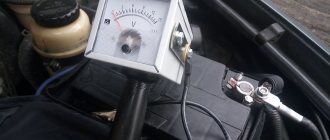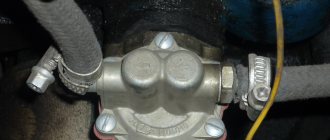The Soviet and Russian car VAZ-2107 is a classic of the domestic automobile industry of the last century. Despite the fact that this car has a truly huge margin of safety, as the years go by, various parts and functional components of the vehicle begin to fail.
Often, drivers of the legendary “Seven” are faced with battery failure. The lamp indicating that the device is working simply stops lighting, and the electric battery itself refuses to charge. This article describes in detail why the VAZ-2107 battery loses charging, and what to do about it.
Generator VAZ 2107 purpose and main functions
The performance of the battery on a VAZ-2107, as on many other cars, depends on three main parts: a generator, a voltage regulator, and connection systems for these two devices.
A machine generator set, a generator, is an element that performs the task of providing electricity to various components of the car, as well as providing a constant charge to the battery. The main components of the generator set include:
- housing with windings;
- anchor;
- current rectifier;
- stabilizer.
The generator set operates through a drive - a belt passing from the crankshaft pulley.
Theory “on fingers”: how everything works
On the VAZ 2107, devices can receive power from 2 sources. The first is the battery, the second is the generator. The battery supplies energy when the engine is turned off. It has a certain charge, consumed as needed. The generator produces electricity, but only if the rotor is spinning. That is, with the engine running.
Battery operation diagram: 1. Battery, 2. Negative diode, 3. Additional diode, 4. Generator, 5. Positive diode, 6. Stator winding, 7. Regulator, 8. Rotor winding, 9. Capacitor, 10. Mounting block, 11. Control lamp, 12. Voltmeter, 13. Ignition relay, 14. Lock.
The battery charge is used to start the engine. When the engine starts running, the battery energy is not consumed: the generator supplies all devices with it. A charge is also supplied to it to restore wasted energy. But if the battery is not charging, its own energy will be enough for a limited number of starts. The battery will then be completely discharged. And the car owner will have to solve the problem of how to start a VAZ 2107 if the battery is dead. After all, not everyone has “crocodiles” in their trunk, and not everyone will agree to share electricity with their battery.
No charging - signs
A situation in which the generator has ceased to perform its main tasks of providing electrical energy to the battery can be determined using the following symptoms:
- the battery loses charge at an increased rate;
- frequent signals from the corresponding lamp on the dashboard;
- The performance level of electrical appliances in the car has decreased.
A driver who notices one of these situations, or all at once, will be able to conclude that the on-board generator is faulty.
Signal lamp
The Russian VAZ-2107 car is equipped with an on-board instrument panel, on the panel of which there are indicators indicating, among other things, the presence of structural problems. One of the lights is responsible for transmitting information regarding the stability of the generator: if the circuit is operating normally, the indicator lights up only when ignited, exactly until the propulsion system starts.
Please note: proper operation of the unit means that the warning light should go out immediately after the engine is started. If the indicator continues to light, there is a problem in the circuit.
Battery drains quickly
Problems that occur during operation of the generator set will immediately affect the state of charge of the battery. A faulty generator will not be able to provide the required level of electrical voltage necessary to properly charge the battery. The driver can determine the insufficient amount of charge in the battery by the occurrence of difficulties when starting the engine.
Reduced electrical performance
Since the generator works to provide on-board electrical devices with the required amount of energy, its malfunctions will lead to malfunctions in the operation of various devices. A driver who suspects a malfunction should try to put into operation any components that require electricity to function: for example, turn on the headlights or heating unit.
A decrease in the performance of these devices - insufficiently bright light and weak fan rotation - will be signs of generator failure.
Burnt out battery indicator light
A fairly common cause of this problem is lamp failure. This is perhaps one of the simplest breakdowns, but it is not always harmless. It is advisable to replace the light bulb as quickly as possible. If there are problems with it, you will not be able to identify the problem with the generator in a timely manner. Which will lead to the battery being discharged at the most inopportune time. Thus, driving with a burnt-out lamp is highly not recommended.
Battery charge indicator light VAZ
You should also consider the design features of your car. Most generators have a built-in resistance. This allows you to generate energy even when the charge control lamp is burnt out. On some cars, the lamp itself plays the role of resistance.
This can be found on some modifications of the VAZ 2112, as well as many old foreign cars. In this case, when the light bulb burns out, the generator stops producing current. If your car has this structure, you should always have a spare lamp.
Reasons for lack of charging
There are a number of main reasons why the VAZ-2107 battery stops charging:
- drive belt deformation;
- loosening of the drive belt;
- damage to wiring or oxidation of terminals;
- problems in the rectifier area;
- regulator damage;
- violation of the integrity of the generator windings.
Each malfunction can lead to a lack of high-quality battery charge.
Belt break
According to the technical documentation, the drive belt should be replaced every fifty thousand kilometers. Such a breakdown is not extremely dangerous only if its presence was detected as soon as possible. A broken belt can lead to heating of the engine part - therefore, when the corresponding signals appear on the on-board panel, you should immediately check the integrity of this unit. This can be done through a visual inspection of the generator part of the machine.
Loosening the belt
The drive belt is a functional unit of the generator set that operates under constant physical tension. The main sign that the belt is loose is a characteristic whistling sound that gets worse in rainy or humid weather. The indicator may not inform the driver about such a malfunction, so you should monitor the belt tension level yourself.
Open circuit and terminal oxidation
The battery of a VAZ-2107 car will stop charging if the wires connecting various parts of the generator set are broken. The electrical circuit that provides a constant charge to the machine battery is extremely simple: a single cable connects the storage device to the terminal on the generator. In order to determine the problem, you should check for contact between the specified nodes.
Input and output terminals may also degrade due to long-term use. You can check their quality condition through visual inspection.
Failure of the rectifier module
A rectifier is a device responsible for converting alternating current into direct current. The unit is made in the form of a board that includes several silicon diodes, each of which can break. If the diode is broken, the rectifier ceases to perform its main task, as a result of which the unit must be replaced.
Regulator failure
A regulator is a device responsible for stabilizing the voltage supplied to the battery. In the event of a breakdown, it must be immediately replaced, since it is not possible to repair the unit.
Malfunction of phase windings
The generator windings are the main functional part of the installation. If a break or short circuit occurs, the device simply stops performing its tasks. Such a breakdown can be determined by the appearance of a characteristic burning smell, as well as by the noise effects noticeable when the element is operating. Diagnosis of such problems is carried out by removing the generator and thoroughly inspecting it.
A few more words about the voltage regulator
Finally, it should be added that in cars such as the VAZ 2107, it is necessary to check the voltage supplied from the generator to the battery with a voltmeter at least once a month. We discussed how to do this above. The fact is that a car device that shows the battery charge level very often lies, showing us the norm, while the voltage at the battery terminals during engine operation is lower or higher than it. And here the danger is not so much the lack of charging as the so-called overcharging. It occurs when the voltage regulator malfunctions and is characterized by the supply of voltage to the battery, the value of which is greater than prescribed.
I personally had to face a similar problem. It all started when the relatively new battery stopped holding a charge. When using the car every day, it started without problems. But as soon as the car sat for a week, the starter made it clear with its clattering that it would not work without the “lighting” wires. A visit to an auto electrician showed that the outermost “bank” of the battery was swollen. This means that the electrodes in it are short-circuited. Why did they suddenly close if everything was in order? After starting the engine, the electrician measured the voltage at the battery terminals. The voltmeter showed 17.2 V, which is unacceptable for this battery model. At the same time, the device on the panel faithfully gave out the “norm”. Checking the voltage regulator confirmed the auto electrician's diagnosis. It was faulty. Replacing the device took no more than half an hour. And the repairs, it would seem, didn’t cost much. The battery, of course, had to be replaced, since with the onset of cold weather it began to discharge even faster.
About six months later, I accidentally noticed that the car’s headlights began to shine noticeably brighter. Then one of the headlights burned out. A week later, another one burned down. Without waiting for the battery to swell again, I decided to carry out diagnostics and repairs myself. Armed with a multimeter, I went to the garage. The measurement results again showed that the voltage regulator was faulty. This time the generator produced 15.6 V. I no longer went to the electrician. I removed the generator myself, replaced the regulator and installed everything in place. The control voltage measurement showed 14.2 V. After that incident, I regularly measure the voltage twice a week. More than a year has passed and everything is back to normal.
Unfortunately, the VAZ 2107 cannot be called a reliable car. But it still has one advantage - simplicity of design. Therefore, it is not at all necessary to contact specialists if minor malfunctions occur.
What to do if the battery is boiling
You can conclude that the VAZ-2107 battery is “boiling” if the following problems occur:
- the corresponding indicator stops lighting;
- the voltmeter behaves inappropriately, and its needle goes to the right;
- A characteristic odor appears in the car interior.
“Boiling” of the battery is caused by problems with the voltage stabilizer. It is strictly forbidden to continue driving the car in such a situation: this can lead to breakdowns of all electrical equipment in the car. In order to get to the service center with safety for yourself and the car, you should forcefully turn off the generator set.
This can be done by physically removing the wire from the terminal with the abbreviation “61” located on the generator itself. The car will continue to move solely using the accumulated charge.
Blown fuse
A failed dashboard light may be caused by a blown fuse. In this case, several devices usually fail at once. If such a symptom appears, you just need to check the fuse. It is located in the mounting block.
Mounting fuse block VAZ 2107
You can find it using the diagram on the block cover. To check, the fuse is removed from the mounting block. The easiest way is to install a known good fuse. If this is the reason, then the light should light up when the ignition is turned on. You can also check the fuse by measuring the resistance with a multimeter.
Diagnostics and repair work
The diagnostic measures necessary to identify problems with the battery not charging are carried out in the following order:
- you should stop driving and turn off the engine;
- lift the hood and conduct a visual inspection of the belt;
- Check the belt tension using a screwdriver or other tool. The normal deviation is 12-17mm;
- If the belt is loose, tighten it. To do this, pick up a 17mm wrench and unscrew the mount of the generator to the bracket. Using a screwdriver, move the unit to the side away from the cylinders. Tighten the fastener and recheck the tension;
- Check for contact between the battery and the alternator using a tester. This can be done by attaching the device to the positive on the battery and the terminal with the abbreviation “30” located on the installation. If the tester does not indicate the presence of contact, replace the cable;
- Using a voltmeter, obtain voltage data at the battery terminals. The normal indicator is 11-12 volts, in working condition - 13.5-14 volts.
If the data obtained is not comparable with normal values, the breakdown should be looked for in the functional components of the generator set, after removing it from the machine.
Alternator belt tension
Tensioning the generator drive belt is quite simple. To do this, you need to unscrew the fastening that mounts the unit to the corresponding bracket, using a 17 key. Using some kind of pry bar of a suitable size, move the generator towards the cylinders. Next, you need to tighten the fastener, and then perform another tension check. The normal deviation of a tensioned belt ranges from 12mm to 17mm.
Video belt tension
More information about tensioning the alternator belt is described in this video:
Dismantling the generator
In case of breakdowns in the rectifier, stabilizer or windings, the generator set must be dismantled. This can be done according to the following step-by-step instructions:
- open the hood, disconnect the wires coming from the unit to the battery;
- using a 17mm wrench, unscrew the nut at the place where the unit is attached to the bracket;
- move the generator into the cylinder area using a screwdriver or a suitable pry bar;
- remove the belt;
- disconnect the terminal block;
- unscrew the nut from the terminal under the abbreviation “30”, then move the wires to the side;
- unscrew the nut that secures the generator housing to the bracket. Remove the fastening bolt;
- Remove the generator set by sliding it to the bottom of the vehicle.
Next, you can carry out diagnostic and then repair work to replace the functional elements of the generator.
Video of generator removal
For more information on how to remove the generator from a VAZ-2107 car, see this video:
Checking the stabilizer rectifier module and windings
To carry out diagnostic work to check the operability of the rectifier, you should prepare a multifunction tester and two pieces of cable with clamps. Next, perform the following steps:
- set the tester to the mode for obtaining data on the resistance indicator;
- look at the resistance between the terminal with the abbreviation “30” and ground. If the indicator is close to zero, there is a short circuit in the rectifier windings or a breakdown of its silicon diode;
- Check positive directional silicon diodes for breakdown. The tester is connected to the terminal with the abbreviation “30” and to any bolt. If the resistance approaches zero, there is a breakdown;
- check the functionality of the negative silicon diodes by attaching the tester probe between the fixing bolt of the device and its body. A breakdown can be concluded if the resistance indicator is zero.
This concludes the diagnostic work. If problems occur, the rectifier should be replaced.
Generator repair
If the generator set has been dismantled and problems are found in its component parts, work should be done to replace them. Repair of the VAZ-2107 generator is carried out as follows:
- fix the impeller with a screwdriver;
- unscrew the fixing bolts;
- remove the pulley parts;
- unscrew the bolts securing the cover. Take out the pin;
- use a hammer to knock off the stator cover;
- remove the bushing located under the front cover, which also needs to be removed;
- knock out the rotor with gentle blows of a hammer;
- unscrew the nuts securing the rectifier to the winding terminals;
- unscrew the nut with the abbreviation “30” and remove the washer;
- replace structural elements;
- assemble the device;
This completes the work of replacing generator parts.
Fuse relay is faulty
Another possible problem is a faulty relay. Some car modifications are equipped with a relay that monitors the battery charge light on the instrument panel. As soon as the relay fails, the indicator does not work either.
Fuse relay VAZ 2107
To test the relay, you should arm yourself with a multimeter. They measure the current at the positive output of the relay. If the voltage is less than 6V, then there is clearly a problem with the generating device. If the value is even higher, then the relay is faulty. It needs replacing.
Thus, finding out the reason why the battery light does not light is extremely important for adjusting the indicator and protecting the car from more serious malfunctions.
VAZ 21074 engine control system diagram
Wiring diagram of electrical connections of ECM VAZ 21074 - circuit elements. 1 – controller connector; 2 – mass air flow sensor; 3 – coolant temperature sensor; 4 – crankshaft position sensor; 5 – throttle position sensor; 6 – oxygen concentration sensor; 7 – speed sensor; 8 – ignition module; 9 – solenoid valve for purge of the adsorber; 10 – electric fan relay; 11 – electric fuel pump relay; 12 – main relay; 13 – fuse for the power circuit of the electric fuel pump relay: 14 – fuse for the power circuit of the main relay; 15 – fuse link; 16-fuse protecting the constant power supply circuit of the controller; 17 – diode; 18 – idle speed regulator; 19 – nozzles; X1 – diagnostic block; X2 – connection block to the vehicle electrical system.
How to change a bearing
During generator repair, the bearing should be checked for play and replaced if necessary. There are two bearings on it: rear 6201 (article - 180201) - 12x32x10, front 6302 (article - 180302) - 15x42x13. For this:
- Remove terminal 30 (nut 6);
- Unscrew two screws and remove the voltage regulator;
- The pulley nut is dismantled;
- The key is removed;
- The bearing lining is dismantled;
- With the help of a device (or without), the old bearing is pressed out and a new one is installed;
- The retaining plate is secured.
Confronting attackers
Due to the fact that the battery is not cheap, the issue of protecting the VAZ 2107 battery from theft is quite acute. It’s not difficult to open the hood of a “classic,” which is why thieves are keeping a close eye on the “Sevens.”
Experts offer several options for preventing theft.
- Secure parking or secure garage.
- installation .
- Installation of the hood lock. Let’s be clear right away: few people take this step. Welding work is required, the appearance deteriorates, and it is quite easy for a professional to pick the lock.
- Take the battery with you. Labor-intensive, inconvenient, but effective. On the other hand, if the car is left for a short time, it is defenseless: they can even remove the battery in a supermarket parking lot.
- Reliable battery fixation. Almost the most popular method. The fasteners are secured with a secret that prevents dismantling and makes theft difficult. In combination with an alarm it is a very effective technique.
But all experts agree that the most reliable protection for the VAZ 2107 battery against theft is comprehensive. A combination of multidirectional measures will give the best results!
More complex breakdowns
If, when the engine is running, the voltage in the on-board network is in the normal range, but when the load increases, it immediately drops, then we can say that the alternator belt is very loosely tensioned. Quite often, at low speeds, the belt even begins to whistle. It should be noted that with normal belt tension, the sag should be no more than 17 mm. Moreover, the force should be no more than 10 kgf. If the belt is very loose, it needs to be tightened. If tension cannot be achieved, a new one should be installed.
Troubleshooting algorithm
There is no need to think that charging is not happening for some very serious reason. Immediately check the condition of fuse F10, which is responsible for powering the excitation winding of the VAZ 2107 generator. But before doing this, it is better to make sure that the drive belt is intact and its tension is normal. But also pay attention to the fact that you cannot over-tighten it - there will be no recharging of the battery (provided that the regulator is operating in the intended mode), but the bearings will fail much faster.
If charging is not going well, the lamp, for example, burns at half intensity, then the fault must be looked for in the wiring. Namely, in the connections between the battery and the car body. Very often oxidation occurs, which prevents normal contact. Unscrew the nut, thoroughly clean the terminal and body surface, and then install the wire in place.
But if everything is fine with the switching, but charging still does not occur, you need to look further for the reason. And the first thing to suspect is the voltage regulator. With its help, the voltage at the generator output is stabilized. If this element fails, the battery overcharges or it does not charge well. Repair of this element is impossible, and the price in stores will be about 300 rubles. There are several options for regulators:
- A separate unit - installed on the body of a VAZ 2107 car.
- Combined with brushes - mounted directly in the generator.
How to check the regulator will be discussed in a separate article. If it is working properly, but charging still does not occur, or it is there, but it does not flow to the battery well, look for a fault in the brush assembly. It is quite possible that the wires that connect the brushes to the contacts have broken. But the most common thing is excessive wear or clogged brushes.
Somewhat less often, failure of the diode bridge or destruction of the stator or rotor windings occurs. To determine these breakdowns, you will need to completely disassemble the generator and carry out diagnostics using a tester and megger. Along the way, of course, it is best to replace the bearings in the VAZ 2107 generator.
Troubleshooting
The first thing to do is check the tension of the alternator drive belt. Let's look at the main reasons why charging on a VAZ-2107 may fail. The reasons can actually be anything - even a simple broken belt. Over time, it wears out and becomes unusable. On the "sevens" the belt also drives the coolant pump. And if the belt suddenly breaks, this can be seen by the fact that the temperature of the antifreeze in the engine block will instantly increase.
If the control light in the dashboard does not light up, and the voltage in the on-board network is at a normal level, but there is still no charging, you can look for the cause of this phenomenon in the terminals and contacts that connect the wires. Remove the terminals from the battery to clean them. Very often they are covered with a layer of oxides that interfere with the conduction of current. The result is a large voltage drop. Quite often, the fault lies not even in the charging wires themselves, but in the bus that connects the body, the engine block and the negative terminal of the battery.











